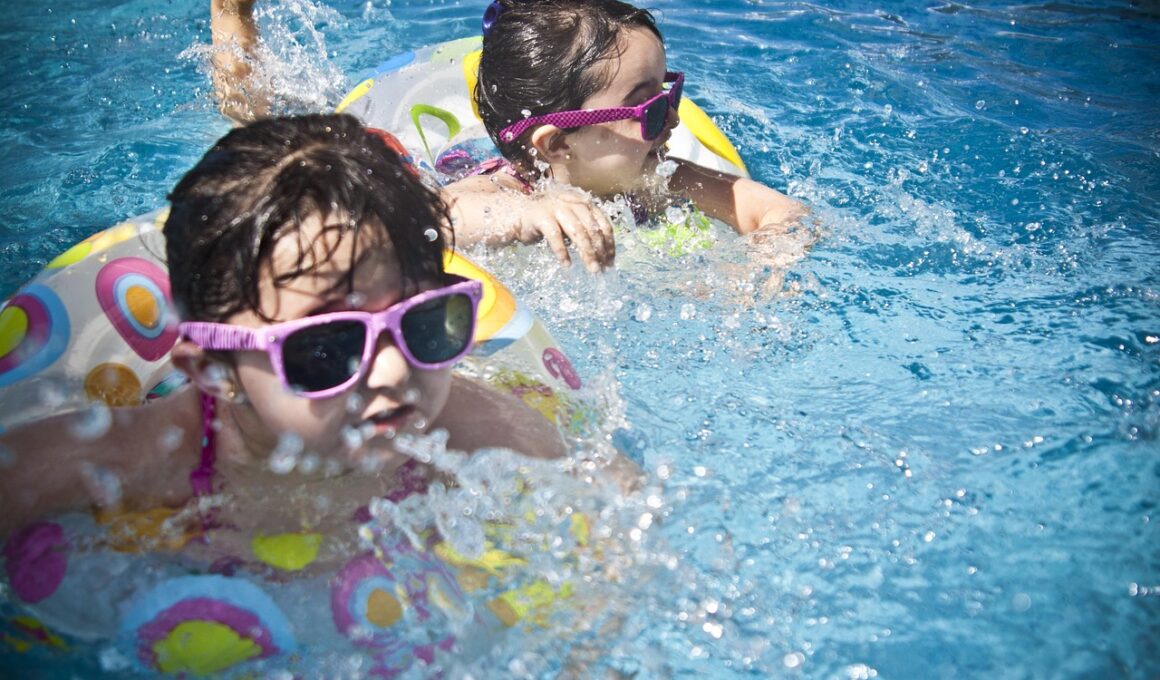Historical Progression of Paralympic Swimming Records
The journey of Paralympic swimming has transformed remarkably since its inception. The first official Paralympic Games took place in Rome in 1960, marking a significant milestone for athletes with disabilities. Initially, the event featured limited swimming categories, reflecting the nascent interest and support for disabled sports globally. As awareness grew, so did the number of events and participants, indicating a shift toward inclusivity. Visionary advocates pushed for more recognition, showcasing the talent and resilience of these athletes. The introduction of classification systems allowed for fair competition across various disabilities. Over the decades, records have been shattered, propelling athletes to surpass benchmarks thought to be impossible. The ongoing evolution of training techniques, equipment, and support systems has played a crucial role. Coaches specializing in adaptive techniques have further refined their strategies, contributing directly to record-breaking performances. Audience engagement and media coverage have also exploded, drawing young swimmers into the sport passionately. As we delve deeper, it becomes evident that the history of Paralympic swimming is not solely about records; it’s about pushing boundaries and inspiring generations.
The Evolution of Records in Paralympic Swimming
From the early days of the Paralympics, swimming records began to emerge symbolically, reflecting the commitment to competitive standards. The first recorded time in the 100m freestyle for male swimmers with disabilities marked the beginning of a progression toward better performance and recognition. Athletes like the legendary Ellie Simmonds exemplify this evolution, achieving miraculous personal records that inspire the entire community. In tandem with the athletes’ efforts, technology played a pivotal role in altering the landscape. Advanced swimsuits and training techniques have become instrumental in enhancing speeds, enabling athletes to race closer to able-bodied records. Through the consistent application of modern coaching methods and psychological training, the approach to preparation has notably shifted. Such innovations contribute significantly to the athletes reaching their peak performance levels. Global competitions, from international championships to the Paralympics, continue to showcase these advancements. As more aspiring swimmers join the ranks, they stand on the shoulders of those who broke barriers before them. Every year witnesses new records being set, and the motivation to excel remains deeply rooted within this remarkable community of athletes.
The impact of international events in the late 20th and early 21st centuries has spurred groundbreaking performances in Paralympic swimming. As ceremonies and events promoted unity, they also fueled a competitive spirit amongst athletes. The establishment of the 2000 Sydney Paralympics became a pivotal moment, propelling the visibility of adaptive sports into the mainstream media. Athletes passionately showcased their skills, demonstrating that physical limitations could be overshadowed by sheer determination. Numerous records were set during these games, raising the bar for future competitions. The alarming focus from sports networks and sponsorships highlighted the closed gap between Paralympic events and their Olympic counterparts. With the rise of grassroots programs and support initiatives, the talent pool for disabled athletes has expanded exponentially. Furthermore, enhanced wheelchair accessibility at pools and venues created opportunities for more athletes to participate. This accessibility helps demystify strengths and achievements while showcasing the dedication required to compete on such a coveted stage. A blend of empowerment and ambition encourages a continuous cycle of record-setting events, pushing athletes further into uncharted waters. The spirit of competition unites every swimmer in their pursuit of excellence.
Significant Milestones and Record Breakers
As we trace the historical timeline of Paralympic swimming, the 2004 Athens Paralympics stands out as a significant milestone. This event saw the introduction of new categories, allowing more athletes to compete, literally showcasing their prowess in the pool. Notably, Brent Lakatos and several other athletes etched their names alongside historic records. Their achievements exemplified the dual nature of sport and ability, proving once again that mental fortitude often triumphs over physical limitations. Competitive spirit witnessed during these events transcended mere athleticism and fostered a sense of camaraderie among swimmers. The storytelling around these athletes adds depth to the records – inspiring not just their competitors and fans but also the world. Records continued to evolve in subsequent years, with every new competition yielding fresh talents, and each achievement encouraging younger swimmers to push for new boundaries. The powerful narratives surrounding these athletes have enriched the swimming landscape, painting a vivid picture of the journey toward breaking barriers. Each swimmer’s personal story intertwines with record achievements, asking future generations to raise their own aspirations higher than ever before.
The classification system integral to Paralympic swimming ensures that competition remains fair while highlighting individual strengths. Athletes are classified based on their disabilities, allowing for equitable competition among varying levels of impairment. This system remains critical in establishing records because it provides a structure that differentiates performances while promoting inclusivity. As swimmers compete for medals, the transparency of classifications helps spectators understand the nuances in performances and records. Each revision of these systems reflects the ongoing commitment to fairness while encouraging more athletes to participate. Alongside evolving classifications, advances in training methodologies have substantially impacted swim techniques. Coaches now utilize sophisticated data analysis and tailor training programs specifically to each athlete’s needs. This tailored approach enhances performance, paving the way for record-breaking swims. Furthermore, improved psychological support nurtures the mental aspect of competition, enabling athletes to confront pressures effectively. Knowledge-sharing between seasoned swimmers and newcomers fosters a sense of community, driving ambition. Records gradually become benchmarks rather than stringent goals, encouraging every individual athlete to continually seek improvement and fulfillment in their swimming journey.
Future Prospects in Paralympic Swimming
The future of Paralympic swimming appears bright, fueled by an evolving landscape of innovation and inclusivity. As technology continues to advance, we can anticipate even more remarkable achievements ahead. Enhanced swimsuits equipped with smart technology are on the verge of becoming commonplace, promising to revolutionize performance levels. Additionally, developments in training facilities will ensure increasingly specialized environments for swimmer training. Grants and sponsorship structures are shifting to embrace these athletes, encouraging more significant investment in their development. Organizations dedicated to promoting disabled sports play a pivotal role in driving these innovations. Continuous support programs empower young swimmers to gain proficiency and discover their potential. Every swimmer entering the world of competitive swimming has the opportunity to inspire others, emphasizing the regarding achievements of their predecessors who perhaps faced steeper challenges. Likewise, media representation is evolving, portraying these athletes in a light that upholds their strengths. Increased engagement will help reach diverse audiences, inspiring the next generation of athletes to take up the sport. Ultimately, the future strengthens the belief that records can always be broken, embodying the relentless spirit of competition.
As we reflect on the historical progression of Paralympic swimming records, it becomes clear that this arena transcends sports; it showcases humanity’s enduring resilience. Each record set tells a story of overcoming challenges, driving athletes toward remarkable achievements that resonate worldwide. Celebrating this history allows us to honor those who have laid the foundation for future generations. The myriad examples of record-setting performances embody inspiration, providing fuel for athletes to push beyond perceived limits. Episodes of perseverance illuminate pathways for young athletes seeking empowerment through sport, while icons like Michael Edgson and others continue to redefine what is possible. As new talents surge into the competitive swimming scene, each performance may lead to another record-breaking moment. Their potential is limitless, driven by collective efforts from coaches, communities, and families. This synergy creates a conducive environment for growth, leaving an indelible mark on history. The triumphs in Paralympic swimming not only create expectations for future elite athletes but also significantly challenge societal perceptions surrounding disabilities. With anticipation for the legacy of records yet to unfold, one can only imagine the incredible journeys ahead.
Every milestone set throughout Paralympic swimming history remains etched in the minds of fans and athletes alike, embodying the spirit of innovation and progress. The communal experience of witnessing these records unfold connects and motivates communities globally, reaffirming their power. Each competition serves as a reminder of how sport unites individuals from different paths, fostering inclusivity while celebrating achievements. As we stand on the cusp of an exciting period for Paralympic swimming, it is crucial to recognize the responsibilities that come with breaking records – inspiring future generations. The journey ahead is as much about achieving competitive greatness as it is about establishing cultural change. Through storytelling, social engagement, and relative visibility, the sport has entered new dimensions, requiring athletes to embrace their roles as pioneers. Today’s endeavors will set the stage for tomorrow’s successes, creating continued momentum towards inclusivity in sports. In doing so, Paralympic swimming will ultimately contribute to altering perceptions beyond athleticism, cementing its legacy in society. The evolution of swimming records is ultimately a powerful testament to human resilience and spirit, ensuring that the inspiration will ripple through generations to come.


